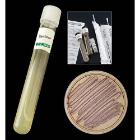You Searched For:
61 results were found
WardsSci000725
Description:
Found on dental plaque, implicated in cavities. No Lancefield group shown, gamma hemolysis.
Description:
Produces orange pigments.
Description:
This organism is normal flora of human intestine and may be pathogenic in humans. This organism will grow in Sodium chloride solution.
Description:
From sewage and human intestine. Causes dysentery.
Description:
No Lancefield group shown, alpha hemolysis. Bile solubility test positive, optochin sensitive. Causes pneumonia.
Description:
This organism is normal flora of human skin.
Description:
All microbial cultures undergo an extensive quality control program prior to releasing for sale, so they are guaranteed for purity as well as for spec...
Description:
Kocuria rhizophila is also commonly known by the name Micrococcus luteus. This organism is commonly isolated from soil, and is frequently used to tes...
Description:
This organism is often times isolated from food; in large amounts it can cause food poisoning
Catalog Number:
(470179-200)
Description:
This organism is normally isolated from soil and is a non-pathogenic strain of the mycobacterium genus.
Catalog Number:
(470179-092)
Description:
From soil and water rich in minerals. Organism of putrefaction.
Description:
Use Sordaria fimicola to allow students to visualize the results of crossing over during cell division.
Description:
This organism is a common environmental isolate, and can be found in soil as well as in industrial settings.
Description:
This organism can be isolated from many human urinary tract infections, as well as polluted water and sewage. It is commonly identified by its distin...
Description:
Isolated from milk, ferments lactose. Lancefield group N, gamma hemolysis
Description:
Noted for capsular swelling. Causes pneumonia and urinary tract infections.
Inquire for Price
Stock for this item is limited, but may be available in a warehouse close to you. Please make sure that you are logged in to the site so that available stock can be displayed. If the
Stock for this item is limited, but may be available in a warehouse close to you. Please make sure that you are logged in to the site so that available stock can be displayed. If the
This product is marked as restricted and can only be purchased by approved Shipping Accounts. To apply for a shipping account number, click here. If you need further assistance, call Customer Service at 800-962-2660 or email [email protected].
-Additional Documentation May be needed to purchase this item. A VWR representative will contact you if needed.
This product has been blocked by your organization. Please contact your purchasing department for more information.
The original product is no longer available. The replacement shown is available.
Limited quantities of this product are available. To check availability or place an order, call Customer Service at 800-962-2660 or email [email protected].
|
|||||||||















